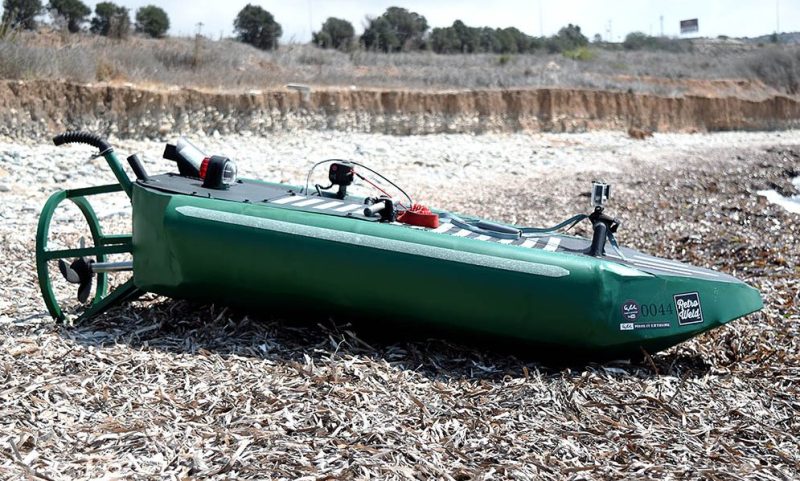It’s the water-borne equivalent of building a minibike out of steel pipe and an old lawnmower engine. Except it’s a DIY personal watercraft made out of aluminum and an old chainsaw, and it has that same garage build feel – and the same disappointing results.
When we first saw the video below, we were hoping for one of those boats that let you water ski by yourself, or a wave-hopping, rooster tailing DIY jet ski. Alas, the chainsaw [MakeItExtreme] chose to power this boat is woefully underpowered, and the boat barely has enough oomph to make a wake. [MakeItExtreme] acknowledges the underwhelming results and mentions plans to fix the boat with a more powerful engine and a water jet drive rather than the trolling motor propeller they used. Still, whatever improvements they make will probably leverage the work they put into the hull, which is a pretty impressive display of metalwork. We’re used to seeing [MakeItExtreme] work in steel, so it was interesting to watch aluminum panels being cut, bent, and welded into a watertight hull. Looks like there’s plenty of room in there for more power, and we’re looking forward to version 2.0 of this build.
If you like rough and ready metalworking videos, there are plenty of them on [MakeItExtreme]’s YouTube channel. We’ve covered quite a few before, including this all-terrain hoverboard and a spot welder that’s more-or-less safe to use.
















There’s also a lot of extra drag from having your feet in the water.
needs a bigger prop
Cavitation, and prop aeration, are the issues.
More power would exacerbate the problem.
I think this was better qualified than some other fails of the week.
I actually considered writing this up as a FOTW but I thought it was pretty clear what the problems are. I like FOTW projects where the cause is a mystery, or where there’s a lot of room to discuss how to improve things. This seems pretty cut and dried. Plus, the hull design and build are impressive, which partially mitigates the failure in my book.
In the writeup he says they tried different props and couldn’t get desired speed. Also in the video you can see he puts his legs on the boat, but speed is still an issue. I guess engine is just too weak, but boat shape can also be an issue.
It might be slow, but it achieves 5 MPG :)
Go Navy! NEED MORE SCREWING! (LOL)
https://www.walmart.com/c/kp/propellers?sort=4
The more expensive 4-blade ones should fix the problem, but you can go down the list to find the cheaper budget 3-blade ones. Quicksilver Thunderbolt would be awesome but the price point is prohibitive. Power is fine. Also elevate your feet onto a higher foot board or something.
The top half of the propeller is higher than the bottom of the boat. There’s no way this can work. Not only is the water reaching the propeller extremely turbulent but if he wants the boat to get up on plane then half the prop will be out of the water as well.
I think the prop shaft is angled downward. And also when he sits on craft, the prop submerges. Did you see what you say in the video? Just asking.
It’s called surface drive. And all the race boats I’ve run use it. The propshaft center line is the water line.
It works fine, when implement correctly
It becomes efficient at higher planing speeds, this is more like a spoiler on a shopping cart.
Yup. Hydroplanes use just this. But there’s a lot science to props or a lot of props to science! they need to think about, and a trolling motor prop probably isn’t cutting it, unless it is someone’s misplaced finger or other appendages XD
Odd hull design. A longer sleeker design with more buoyancy might have worked better if you’re hauling a person on it. How about these boats powered by cordless drills: https://www.youtube.com/watch?v=3Ek0KMOQiUw
These are actually kind of neat. I wonder how long the charge lasts for before having to change the pack?
The square tube prop guard also contributes a lot of drag. Try enclosing the prop in a tube that fits it real close, with the inlet ahead of it gently turned down so it can pull in water unrestricted. If the prop has to be angled down, bend the outlet up so it’s parallel to the bottom of the hull. Also make that part pivot for steering.
The gland (what the things are which seal where shafts penetrate boat hulls) should have a bearing bronze bushing, a seal on both sides and a grease zerk inside the hull to put grease in between the seals. The steel shaft running in aluminum won’t last long, even with grease, especially not with only one side having a seal.
I don’t have much to add to the discussion that hasn’t been said already, but I just thought it was weird to watch the video after being around in a machine shop during fabrication for years… seeing this guy weld on video made me want to turn away/close my eyes/etc even though there’s no way my monitor can hurt my eyes. Strange.